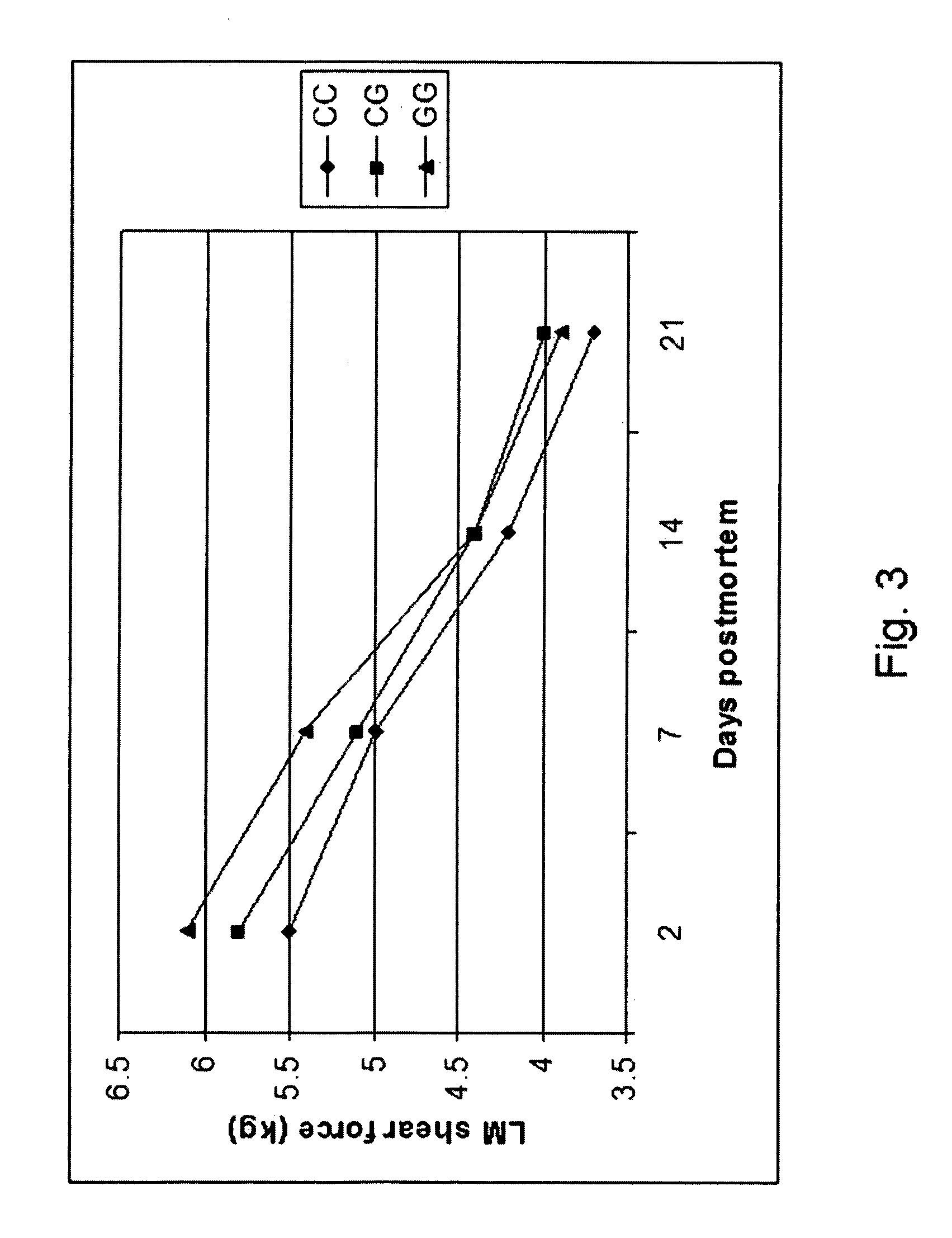Bovine CAST gene SNP and meat tenderness
a cast gene and gene technology, applied in the field of bovine cast gene snp and meat tenderness, can solve the problems of reduced profits, initial studies, and inability to find significant association between cast polymorphisms and tenderness, and achieve the effect of improving the production efficiency of livestock
- Summary
- Abstract
- Description
- Claims
- Application Information
AI Technical Summary
Benefits of technology
Problems solved by technology
Method used
Image
Examples
example 1
Experimental Cattle and DNA Isolation
[0180]A total of 628 animals were genotyped, including commercially fed heifers (163), steers (226) and bulls (61) from beef feedlots in Ontario, and steers (178) from a University of Guelph feeding trial in Rockwood, Ontario. The two sources of cattle were identified as Commercial and Rockwood, respectively. Animals were crossbred with breed composition formed by several breeds. The major contributing breeds were, Angus, Limousin, Charolais, and Simmental. The average contribution of these four breeds to the breed composition of animals having any fraction of the mentioned breeds were 0.46, 0.50, 0.50, and 0.50 for AN, CH, LI, and SM, respectively, for commercial cattle, and 0.51, 0.53, 0.59, and 0.41 for Rockwood cattle. With the primary use of purebred sires, commercial cattle were more representative of first generation crossbreds than Rockwood cattle. Rockwood and commercial cattle represented AI breeding as well as some herd bulls. Animals ...
example 2
Primer Design and Sequencing of Amplified DNA Fragments
[0182]The primers 5′-CCTCGACTGCGTACCAATTCCGAAGTAAAGCCAAAGGAACA-3′(SEQ ID NO: 2) (forward) and 5′-ATTTCTCTGATGGTGGCTGCTCACT-3′(SEQ ID NO: 3) (reverse) were designed based on a partial genomic DNA sequence of the bovine Calpastatin gene (Accession number AY008267) using the software Primer 3. The forward primer comprised a common tail 5′-CCTCGACTGCGTACCAATTCC-3′(SEQ ID NO: 4) as an approach to simplify the sequencing procedures when performing many reactions for different genes.
[0183]The PCR master mix was 6.71 μl H2O, 1.0 μl 10×PCR buffer II, 0.73 μl 25 mM MgCl2 solution, 0.6 μl 10 mM dNTPs Solution, 0.13 μl forward primer (20 pmol / μl), 0.13 μl reverse primer (20 pmol / μl), 0.1 μl AmpliTag Gold (5 U / μl) (Applied Biosystems, Foster City, Calif., USA) and 0.6 μl DNA template (50 ng / μl) in a 10 μl reaction solution. The PCR cycling condition were 95° C. for 10 mins. for 1 cycle, then 94° C. for 30 secs at. 69° C.; 62° C. for 30 secs....
example 3
PCR-RFLP Genotyping
[0184]Individual PCR-RFLP genotypes were distinguished for polymorphisms of the CAST gene at the nucleotide position corresponding to the nucleotide 232 of the sequence SEQ ID NO: 1. The PCR products were digested by Rsa I restriction endonuclease at 37° C. for 4 hrs in a 10 μl reaction solution including a 2.7 μl H2O, 1.0 μl specific NEBuffer, 0.3 μl (3 units) restriction endonucleases, and 6 μl of a PCR product solution. DNA fragments from the digested PCR products were separated by 2.0% agarose gel containing ethidium bromide (0.4 μl / ml). Electrophoresis was performed in a 1×TBE buffer (10×concentrated stock solution: 108 gm Tris, 55 gm boric acid and 40 ml 0.5 M EDTA per liter, pH 8.0) containing ethidium bromide (3 μl of a 10 mg ethidium bromide / ml solution per 100 ml of gel solution) under 120V for about 45 min. The genotype for each individual was read under ultraviolet light, using Molecular Analyst Software (Bio-Rad Laboratories, Molecular Bioscience Gro...
PUM
| Property | Measurement | Unit |
|---|---|---|
| melting point temperatures | aaaaa | aaaaa |
| temperatures | aaaaa | aaaaa |
| temperature | aaaaa | aaaaa |
Abstract
Description
Claims
Application Information
 Login to View More
Login to View More - R&D
- Intellectual Property
- Life Sciences
- Materials
- Tech Scout
- Unparalleled Data Quality
- Higher Quality Content
- 60% Fewer Hallucinations
Browse by: Latest US Patents, China's latest patents, Technical Efficacy Thesaurus, Application Domain, Technology Topic, Popular Technical Reports.
© 2025 PatSnap. All rights reserved.Legal|Privacy policy|Modern Slavery Act Transparency Statement|Sitemap|About US| Contact US: help@patsnap.com



